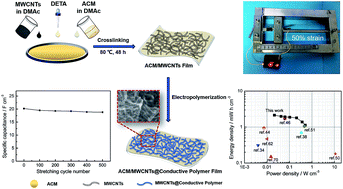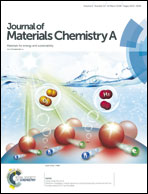High-performance stretchable supercapacitors based on intrinsically stretchable acrylate rubber/MWCNTs@conductive polymer composite electrodes†
Abstract
The key to fabricating high-performance stretchable supercapacitors (SSCs) is the design of intrinsically stretchable electrodes. However, there are few reports focusing on this, especially in organic electrolytes with a broader potential window. In this work, we have fabricated novel intrinsically stretchable electrodes made of acrylate rubber/multiwall carbon nanotube (ACM/MWCNT) composite film supported poly(1,5-diaminoanthraquinone) or polyaniline (ACM/MWCNTs@PDAA and ACM/MWCNTs@PANI). The ACM/MWCNT film with 35 wt% MWCNTs shows a high conductivity (9.6 S cm−1), high stretchability (155%) and good elastic resilience (11.7% plastic deformation after 500 stretching cycles at 50% strain). The ACM/MWCNTs@PDAA anode and ACM/MWCNTs@PANI cathode exhibit a high volumetric specific capacitance of 20.2 and 17.2 F cm−3 at 1 mA cm−2, respectively. To demonstrate the good performance of the as-prepared stretchable electrodes, an organic asymmetric stretchable supercapacitor (oASSC) is assembled conveniently by using ACM/MWCNTs@PANI as the cathode, ACM/MWCNTs@PDAA as the anode, and ACM/Et4NBF4–AN as the quasi-solid-state polymer electrolyte (QPE). The oASSC delivers an outstanding energy density of 2.14 mW h cm−3 and good cycling stability under static and 50% strain conditions, which makes it superior to most reported stretchable supercapacitors.



 Please wait while we load your content...
Please wait while we load your content...